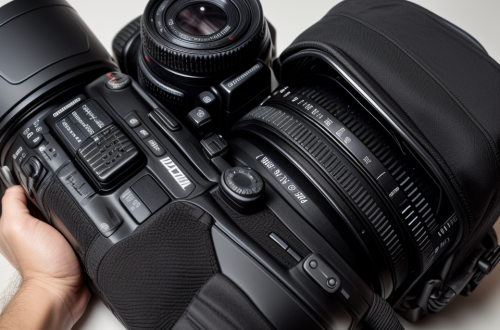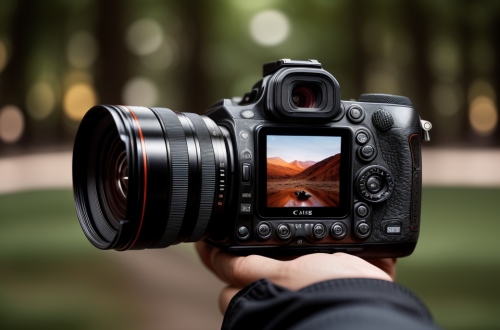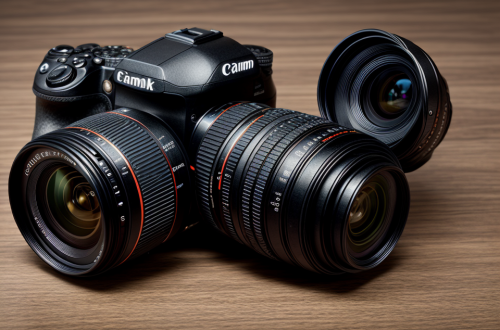In today’s world, cameras are everywhere. From our smartphones to our laptops, we have access to camera technology that was once only available to professionals. But with the rise of camera technology, the question remains, is it worth investing in a camera in 2023? This article will explore the evolution of camera technology and whether it’s still worth it to buy a camera in today’s world.
Investing in a camera in 2023 is definitely worth it. Camera technology has come a long way and continues to evolve, offering photographers and videographers more creative possibilities than ever before. From high-resolution sensors and advanced autofocus systems to features like 4K video recording and real-time Eye AF, modern cameras provide a wealth of capabilities for capturing stunning images and videos. Additionally, with the rise of mirrorless camera systems and mobile camera technology, there are more affordable options available for those just starting out or looking to upgrade their current setup. Overall, investing in a camera in 2023 is a smart decision for anyone looking to take their photography or videography to the next level.
A Brief History of Camera Technology
The Evolution of Film Cameras
From Box Cameras to Leica Ms: A Timeline of Film Camera Advancements
Box Cameras: The Early Stages of Film Photography
- Box cameras, also known as “box Kodaks,” were some of the earliest film cameras ever produced.
- They were small, portable, and simple in design, making them accessible to the average person for the first time.
- The introduction of box cameras marked the beginning of a new era in photography, making it possible for people to capture and preserve memories outside of the studio setting.
The Advent of 35mm Film Cameras: Leica and Its Rivals
- 35mm film cameras, such as the iconic Leica, represented a significant advancement in film camera technology.
- They were smaller and more lightweight than their predecessors, making them easier to carry and use on the go.
- The Leica, in particular, became known for its sharp focus and high-quality images, making it a popular choice among professional photographers.
The Golden Age of Film Cameras: Rangefinders and SLRs
- The golden age of film cameras was marked by the development of rangefinders and single-lens reflex (SLR) cameras.
- Rangefinders, such as the legendary Leica M6, combined the compact size of box cameras with the precision of SLRs, making them a popular choice among photographers who valued both form and function.
- SLRs, on the other hand, offered a more complex and sophisticated design, with interchangeable lenses and a split-prism viewfinder that allowed for more accurate focusing.
The Decline of Film Cameras: Why Digital Won the War
- The decline of film cameras can be attributed to the rise of digital technology and its many advantages over film.
- Digital cameras offered greater convenience, higher image quality, and greater accessibility, making them a more attractive option for many photographers.
- Additionally, digital cameras eliminated the need for film processing and printing, further reducing costs and simplifying the photography process.
The Current State of Camera Technology
Mirrorless vs. DSLR: The Great Debate
Mirrorless Cameras: The Future of Photography?
Mirrorless cameras have become increasingly popular in recent years, with many photographers praising their smaller size, faster autofocus, and higher image quality. Mirrorless cameras are essentially digital cameras that do not have a mirror to reflect the light from the lens to an optical viewfinder. Instead, they use an electronic viewfinder or the rear LCD screen to preview the image.
Advantages of Mirrorless Cameras
- Smaller size and lighter weight
- Faster autofocus and more accurate eye-detection
- Sharper 4K video
- Better battery life
- More affordable price
Disadvantages of Mirrorless Cameras
- Lack of an optical viewfinder
- Less extensive lens selection
- Higher cost for high-end models
- Less rugged construction
DSLRs: A Dying Breed?
DSLRs, or digital single-lens reflex cameras, have been the go-to camera for professional photographers for decades. However, with the rise of mirrorless technology, some experts predict that DSLRs will soon become obsolete.
Advantages of DSLRs
- Optical viewfinder with better image quality
- Larger selection of lenses
- Better low-light performance
- More rugged construction
- Familiar interface for experienced photographers
Disadvantages of DSLRs
- Heavier and bulkier than mirrorless cameras
- Lower battery life
- Slower autofocus
- Less sharp 4K video
Smartphone Cameras: The Unstoppable Force
The Evolution of Smartphone Cameras
The smartphone camera has come a long way since the first camera phone was introduced in 2000. Back then, the camera had a resolution of just 0.3 megapixels, which was barely enough to capture a clear image. However, since then, smartphone cameras have evolved dramatically, with some of the latest models boasting up to 108 megapixels.
From 2MP to 108MP: The Megapixel Race
The megapixel race is one of the most significant factors that have driven the evolution of smartphone cameras. Manufacturers have been competing to pack more megapixels into their smartphone cameras, which has led to a significant improvement in image quality. In fact, some of the latest smartphones, such as the Samsung Galaxy S21 Ultra and the Xiaomi Mi 11T Pro, have up to 108 megapixels, which is more than most standalone cameras.
Camera Features: Zoom, Aperture, and Stabilization
Apart from megapixels, other camera features have also improved significantly in recent years. For instance, smartphone cameras now come with advanced zoom capabilities, allowing users to zoom in on distant objects without sacrificing image quality. Additionally, many smartphones now have adjustable apertures, which allow users to control the amount of light that enters the camera, resulting in better low-light performance. Furthermore, most smartphones now come with optical image stabilization, which helps to reduce blur when taking photos or recording videos.
Smartphone Cameras vs. Professional Cameras: How They Compare
While smartphone cameras have come a long way, they still cannot match the capabilities of professional cameras. For instance, professional cameras offer more manual controls, allowing users to fine-tune settings such as shutter speed, aperture, and ISO. Additionally, professional cameras typically have better image quality, especially in low-light conditions, and can shoot higher-quality video. However, for most casual users, the difference in image quality may not be noticeable, and the convenience and portability of smartphone cameras make them an attractive option.
Is Buying a Camera Worth It in 2023?
The Pros and Cons of Owning a Camera
Pros of Owning a Camera
Superior Image Quality
Owning a camera comes with the benefit of superior image quality compared to smartphones or other compact cameras. With advanced sensor technology and higher resolution capabilities, cameras can capture stunning images with more detail and dynamic range. Additionally, cameras offer greater control over exposure settings, allowing for more creative freedom in capturing the perfect shot.
Control Over Settings and Features
One of the advantages of owning a camera is the ability to have full control over various settings and features. From aperture and shutter speed to ISO and white balance, photographers can adjust these settings to achieve the desired look and effect in their images. This level of control is not possible with smartphones or other compact cameras, which often have limited manual controls.
Dedicated Accessories and Lenses
Another benefit of owning a camera is the ability to use dedicated accessories and lenses. While smartphones may have built-in lenses, these are often limited in terms of zoom and aperture. With a camera, photographers can invest in high-quality lenses that offer greater flexibility and capabilities. This allows for more creative expression and the ability to capture a wider range of subjects and scenes.
Cons of Owning a Camera
Cost
One of the primary drawbacks of owning a camera is the cost. While entry-level cameras can be relatively affordable, high-end models can be quite expensive. Additionally, lenses and accessories can add to the overall cost, making it a significant investment for some photographers.
Weight and Portability
Another potential downside of owning a camera is the weight and portability. While some cameras are designed to be compact and lightweight, others can be quite bulky and heavy. This can make it difficult to carry a camera with you at all times, limiting the spontaneity and convenience of shooting with a smartphone.
Learning Curve
Finally, owning a camera requires a learning curve. While some photographers may be familiar with the basics of photography, others may need to learn more about exposure, composition, and other technical aspects of photography. This can be a steep learning curve for some, particularly for those who are used to the simplicity of shooting with a smartphone.
The Role of Camera Phones and Professional Cameras in 2023
Camera Phones: A Game-Changer
In recent years, camera phones have experienced a significant transformation, making them a viable alternative to traditional point-and-shoot cameras and even professional cameras for many users. These devices now offer features that were once exclusive to dedicated cameras, such as advanced optics, AI-powered features, and enhanced low-light performance. As a result, they have become a game-changer in the world of photography.
Improved Low-Light Performance
One of the most notable advancements in camera phone technology is their ability to capture high-quality images in low-light conditions. This is made possible by the use of larger sensors, improved image processing algorithms, and software-based noise reduction techniques. Consequently, users can now capture stunning images without the need for external light sources or the use of a tripod.
Enhanced Optical Zoom
Another significant development in camera phone technology is the enhanced optical zoom capabilities. Many modern smartphones now feature up to 10x optical zoom, which allows users to capture distant subjects with remarkable clarity. Additionally, some devices offer digital zoom options that can extend the focal length beyond the physical limitations of the lens, although this may result in a loss of image quality.
AI-Powered Features
Artificial intelligence (AI) has also played a crucial role in the evolution of camera phone technology. AI-powered features such as scene detection, object recognition, and image stabilization have become commonplace in modern smartphones. These features help users capture better images by automatically adjusting settings such as exposure, focus, and white balance based on the shooting conditions. Furthermore, AI-powered editing tools enable users to enhance their images with just a few taps on their smartphone screens.
Professional Cameras: Still Relevant?
While camera phones have come a long way, professional cameras still hold their own in certain areas. For those who require the highest level of image quality, control, and versatility, professional cameras remain a relevant investment.
High-End Performance
Professional cameras offer superior image quality compared to camera phones, particularly in terms of dynamic range, color accuracy, and noise reduction. They are designed to capture high-resolution images with exceptional detail and accuracy, making them ideal for professional photographers, videographers, and serious enthusiasts.
Professional Features and Lenses
Professional cameras come with a wide range of features and accessories that are tailored to the needs of professional photographers. These include interchangeable lens systems, advanced autofocus systems, high-speed continuous shooting, and 4K video recording capabilities. Additionally, professional cameras often offer greater customization options, such as manual controls over aperture, shutter speed, and ISO settings, giving users complete creative control over their images.
Investment for Aspiring Professionals
For aspiring professional photographers, investing in a professional camera can be a valuable investment. While the initial cost may be substantial, professional cameras offer a higher resale value compared to camera phones, and the lenses and accessories can be used across multiple camera bodies. Moreover, professional cameras provide the necessary tools and capabilities to help aspiring photographers develop their skills and transition into a professional career.
The Camera Landscape in 2023 and Beyond
The Evolution of Camera Technology: What to Expect
As technology continues to advance, cameras are becoming more sophisticated and versatile. Here are some trends to expect in the coming years:
Mirrorless and DSLR: A Merge?
The mirrorless camera market has been growing rapidly, with many photographers switching from traditional DSLRs. This is due to the advantages of mirrorless cameras, such as smaller size, better autofocus, and faster continuous shooting. However, DSLRs still have their loyal following, particularly among sports and wildlife photographers. It’s possible that we may see a merging of the two technologies in the future, with cameras that offer the best of both worlds.
The Future of Smartphone Cameras
Smartphone cameras have come a long way in recent years, with many high-end smartphones sporting sensors and lenses that rival some entry-level cameras. While smartphones will never replace dedicated cameras for professional use, they will continue to improve and may be sufficient for casual photographers.
Niche Markets and Specialized Cameras
As technology advances, we may see more specialized cameras catering to specific niches, such as underwater photography, astrophotography, and 360-degree panoramic photography. These cameras will likely offer unique features and capabilities not found in traditional cameras.
Making the Right Choice for Your Needs
With so many options available, it’s important to assess your photography goals and needs before investing in a camera. Consider factors such as budget, portability, image quality, and features. Don’t forget to factor in the cost of lenses and accessories as well.
FAQs
1. Is it worth investing in a camera in 2023?
Yes, investing in a camera in 2023 is still worth it. With the advancements in camera technology, cameras are now more accessible and offer higher quality than ever before. Whether you’re a professional photographer or a hobbyist, having a camera can help you capture stunning images and memories that you can treasure for years to come.
2. What type of camera should I buy?
The type of camera you should buy depends on your needs and budget. If you’re a beginner, a smartphone camera or a point-and-shoot camera can be a great starting point. For those who want more control over their shots, a DSLR or mirrorless camera can provide better image quality and versatility. It’s important to consider factors such as the camera’s sensor size, lens options, and features when making your decision.
3. How has camera technology evolved over the years?
Camera technology has come a long way since the early days of photography. From film cameras to digital cameras, the technology has improved dramatically. Today’s cameras offer higher resolution, better low-light performance, faster autofocus, and more advanced features such as 4K video recording and wireless connectivity. These advancements have made it easier and more affordable for people to capture high-quality images and videos.
4. Can’t I just use my smartphone camera?
While smartphone cameras have come a long way and can produce great results, they still have limitations compared to dedicated cameras. Smartphone cameras often have smaller sensors, less versatile lenses, and limited manual controls. If you’re serious about photography or want to take your camera skills to the next level, investing in a dedicated camera can provide you with more creative control and better image quality.
5. How often should I upgrade my camera?
The frequency of camera upgrades depends on your needs and budget. If you’re a professional photographer who relies on your camera for work, you may need to upgrade more frequently to keep up with the latest technology. For hobbyists or casual users, upgrading every few years should be sufficient. Ultimately, it’s important to consider how much you’ll use your camera and whether the latest features and improvements are worth the investment.





